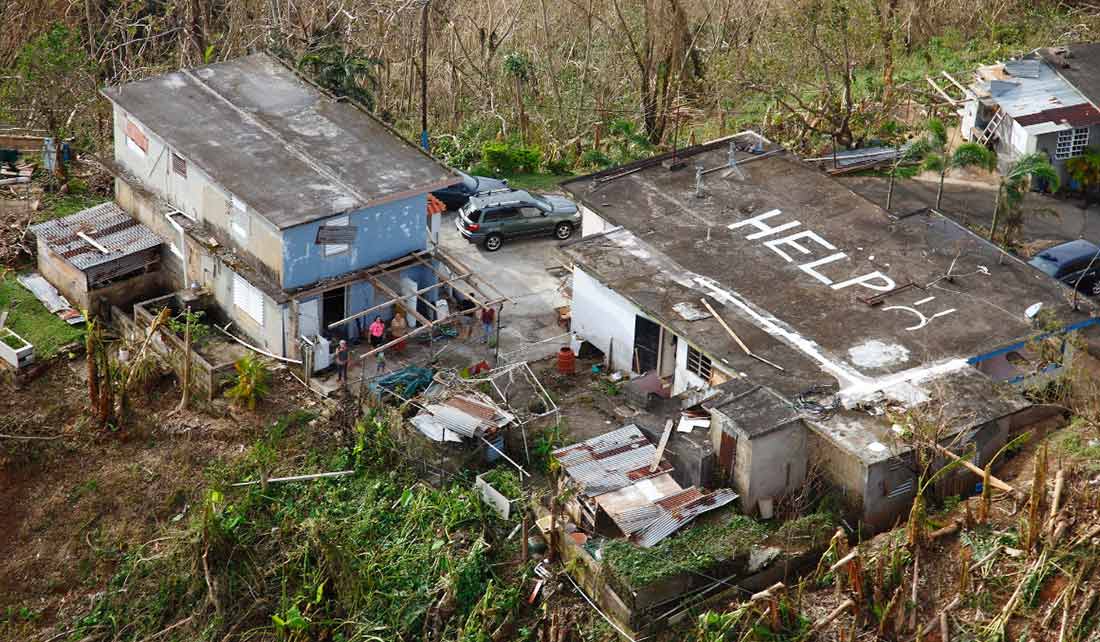
Conditions in Puerto Rico have been described as “apocalyptic” as limited airport access and damaged airfields make relief difficult. U.S. Customs and Border Protection/Twitter
At least 10 people are dead and as much as $85 billion in insured losses have been reported since Hurricane Maria hit Puerto Rico as a Category 4 storm last Wednesday. Some officials have called the aftermath "apocalyptic," while one said Maria set Puerto Rico back "20 to 30 years." San Juan Mayor Carmen Yulín Cruz painted an even grimmer picture of what's to come, while Gov. Ricardo Rosselló said Puerto Rico is "essentially devastated."
On Monday, the FAA announced that San Juan's Luis Muñoz Marín International Airport would resume limited commercial airline service, with "more than a dozen" flights getting people off the island while technicians continued the seemingly impossible effort of restoring radars and other equipment. One long-range radar was so difficult to reach — the final miles to the site were "impassable" — that workers had to use chainsaws to get replacement equipment and techs through.
CBS News correspondent David Begnaud offered a look inside the Caribbean’s busiest airport, and he said a nurse from Little Rock referred to it as a humanitarian crisis.
By Tuesday the number of flights had increased to 36 per hour, and Rafael Hernández Airport in Aguadilla also resumed limited operation for relief flights. However, many commercial flights were still canceled and others were limited because of the priority given to relief flights. American Airlines, according to the N.Y. Times, packed incoming flights with up to 50,000 pounds of supplies and relief cargo, before departing with people looking to escape the damage to their homes, extreme heat and even violence and looting. In Chicago, evacuees erupted with applause as their plane landed at O'Hare International Airport, where they were greeted by Red Cross workers offering bottled water and food.
Travelers have also played the waiting game to get back to Puerto Rico to assess the damage and help their loved ones. Even relief workers have been bounced from flight to flight by cancellations and the lack of availability at Marín airport, where regular operations are expected to resume on Thursday.
Still, more help is on the way. The U.S. military will soon deploy the USNS Comfort hospital ship to assist FEMA, and rescue missions are already underway by the USS Kearsarge Amphibious Ready Group, which had performed 148 airlifts as of Tuesday. The 101st Combat Aviation Brigade, which recently conducted relief efforts following Irma, was also in action on Tuesday, sharing an image (above) of a medical evacuation helicopter being loaded onto a C-5. Approximately 70 soldiers and eight helicopters will be sent from Fort Campbell to Puerto Rico.
Chairman of the Joint Chiefs Gen. Joseph Dunford said on Tuesday that despite damage to ports and the island's other airfields, the military is doing all it can to help Puerto Rico. When asked if they could be doing more, he replied: "If there is, we'll be doing it." He added, "All the other support they need can't come in until we get the ports and airfields open, so that's why Northern Command has placed that at the top of the list in terms of the support we're providing."
President Donald Trump announced that he will visit Puerto Rico next week, so that he won't interfere with the efforts of first responders. The House will also once again try to pass an FAA reauthorization plan ahead of Saturday's expiration of the current deal, and in addition to a six-month extension for aviation programs, it will include tax and other financial relief for victims of recent hurricanes. House Democrats reportedly rejected the deal on Monday because they don't believe it offers enough relief. Another vote is expected soon.

Sign-up for newsletters & special offers!
Get the latest FLYING stories & special offers delivered directly to your inbox






